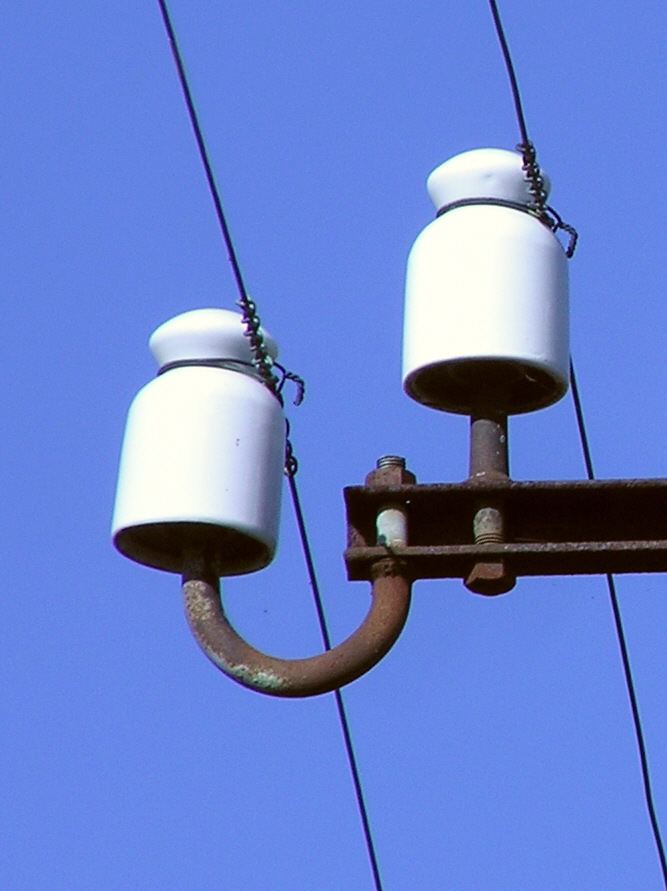 | ||
A Pin Insulator is a device that isolates a wire from a physical support such as a pin (a wooden or metal dowel of about 3 cm diameter with screw threads) on a telegraph or utility pole. It is a formed, single layer shape that is made out of a non-conducting material, usually porcelain or glass. It is thought to be the earliest developed overhead insulator and is still popularly used in power networks up to 33 KV. Single or multiple pin insulators can be used on one physical support, however, the number of insulators used depends upon the application's voltage.
Contents
Pin insulators are one of three types of overhead insulators, the others being Strain insulators and Suspension insulators. Unlike the others, pin insulators are directly connected to the physical support compared to being suspended from the wire. Pin insulators are shaped to allow the secure attachment of the conducting wire and avoid it coming adrift. The wire is usually attached to the insulator by being wrapped around it or in other circumstances, fixed into grooves on the insulator itself.
When insulator is wet, its outer surface becomes almost conducting making the insulator less effective. To combat this problem the insulator has an umbrella like design so that it can protect the lower part of the insulator from rain. The upper surface is also inclined as less as possible to maintain it's effectiveness when raining. To keep the inner side of the insulator dry, rain sheds are made and these do not disturb the insulator's effectiveness or voltage distribution.
Collecting Pin Insulators
Over time, Pin insulators have become collectible items. All glass Pin Insulators are assigned a Consolidated Design (CD) number, a system first implemented by hobbyist N.R. Woodward in 1954. Each CD number corresponds to a specific glass style, shape or manufacturer. Also, CD numbers are only hobby-specific for collectors, and are not used or recognised by insulator manufacturers.
Insulators, at the time of manufacturing, were simply viewed as an engineering product and were not meant to be an entertainment product for spectators. This meant that the quality of the insulators was not a primary concern of the manufacturers that made them. The finished product was usually discoloured from impurities and foreign objects diffused within the molten glass and metal moulds. These impurities give the insulator a unique character and high value as collectors would rather obtain an imperfect product rather than a perfect, common product. Impurities in the glass can create amber swirls; milk swirls; graphite inclusions and two or three-tone insulators. Foreign objects contained within the glass are known to be nails; pennies and screws.
Although glass insulators are the most popular for the majority of collectors, a number of people collect porcelain insulators as well. These also come in a variety of shapes, sizes, and colors.
Today there are clubs in the US that are dedicated to collecting Pin Insulators. A list of these clubs by US State can be found at http://www.insulators.info/clubs/
Manufacturers
One of the major US manufacturers that produced glass insulators during the 19th century and early 20th century in the USA was Brookfield Glass Company. It can be assumed that Brookfield may have had poor quality control as their insulators seem to be found with the most imperfections, however, this could be disputed.
Another major US manufacturer that produced glass insulators was The Hemingray Glass Company They were known for producing the most variety of colors. Some examples of colors that the company produced are: yellow, golden yellow, butterscotch, glowing orange, amber, whiskey amber, "root beer" amber, orange-amber, red-amber, oxblood, green, lime green, sage green, depression green, emerald green, olive green, yellow-olive green, aqua, cornflower blue, electric blue, cobalt blue, sapphire blue, glowing peacock blue, and many others. Different colors were produced to allow two or more different utility companies to quickly identify which wires were theirs by the color of insulator if multiple wires were strung over the same utility pole. For example, one company may have a string of amber insulators, while another, on the same poles, might have their insulators in cobalt blue.
There are many manufacturers in the US, Canada and international countries that can be found embossed on all styles of insulators. A non-comprehensive list of these manufacturers is below:
US Manufacturers
Canadian Manufacturers
International Manufacturers
